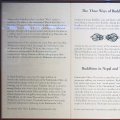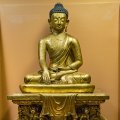Patan Museum (Nepal): photo 111
Photo 111 of 212 in Gallery: Patan Museum (Nepal)

Image title: The Buddha’s Doctrine: The Four Noble Truths
Description of the photo
The Buddha’s Doctrine: The Four Noble Truths:
Early Buddhist doctrine, as formulated by the Historical Buddha, Shakyamuni, is embodied in the Four Noble Truths and the Eight-fold Path. By embracing these tenets, so the Buddha taught, the individual could escape successive rebirths-an Indian belief-with its accompanying sorrows, suffering, and eventual death, and attain nirvana, a state of non-being.
This is the Noble Truth of Sorrow:—Birth is sorrow, age is sorrow, disease is sorrow, death is sorrow, contact with the unpleasant is sorrow, separation from the pleasant is sorrow, every wish unfulfilled is sorrow...
And this is the Noble Truth of the Arising of Sorrow:—It arises from craving...the craving for sensual pleasure, the craving for continued life, the craving for power.
And this is the Noble Truth of the Stopping of Sorrow:—It is the complete stopping of that craving, so that no passion remains...
And this is the Noble Truth of the Way which Leads to the Stopping of Sorrow:—It is the Noble Eightfold Path-Right Views, Right Resolve, Right Speech, Right Conduct, Right Livelihood, Right Effort, Right Mindfulness, and Right Concentration.
Hand Poses of Shakyamuni Buddha
These mudras typify images of the Historical Buddha but are not confined to him alone.
abhaya-mudra—Gesture of reassurance, meaning nave no fear.’ Jr is the most common gesture of Buddhist deities and conveys a benediction or blessing.
dhyani-mudra or samadhi-mudra—Gesture of meditation. In meditation the Buddha is most frequently seated cross-legged, with his funds in his Jap, right over left, palm upward. They may support the monk s begging bowl.
varada-mudra—Gesture of charity, the granting of gifts. The hand is held as if jewels are falling from the palm.
dharmacakra-mudra—Gesture of teaching or preaching termed “turning the Wheel of the Law.” After his enlightenment, the Buddha preached to his followers. The law (dharma) he set in motion is symbolized by a wheel (cakra) a shape without beginning or end. When displayed by the Historical Buddha the gesture refers to the first sermon.
Gallery information:
The Patan Museum is located on the Durbar square of Patan (Lalitpur/Lalitapura, Kathmandu, Nepal) which is associated Keshav Narayan Chowk (Keshavnarayan)—a form of Lord Vishnu. Being listed as a World Heritage Site, the whole of Durbar square is filled with exquisite temples, sculptures and other ancient structures, of which the ancient history history can be traced to the Malla Kings of Lalitpur. It is an important site for both Buddhism and Hinduism.
Photo details:
Date: 2019-12-02
Camera: SONY ILCE-6400
Exposure: 1/160
Aperture: f/3.5
ISO: 2000
Focal length: 18mm
High resolution:
Download file
Size: 4.12 MB
Resolution: 3459 x 2000
© Photograph by Gabe Hiemstra.
License: CC BY-NC-ND 4.0

